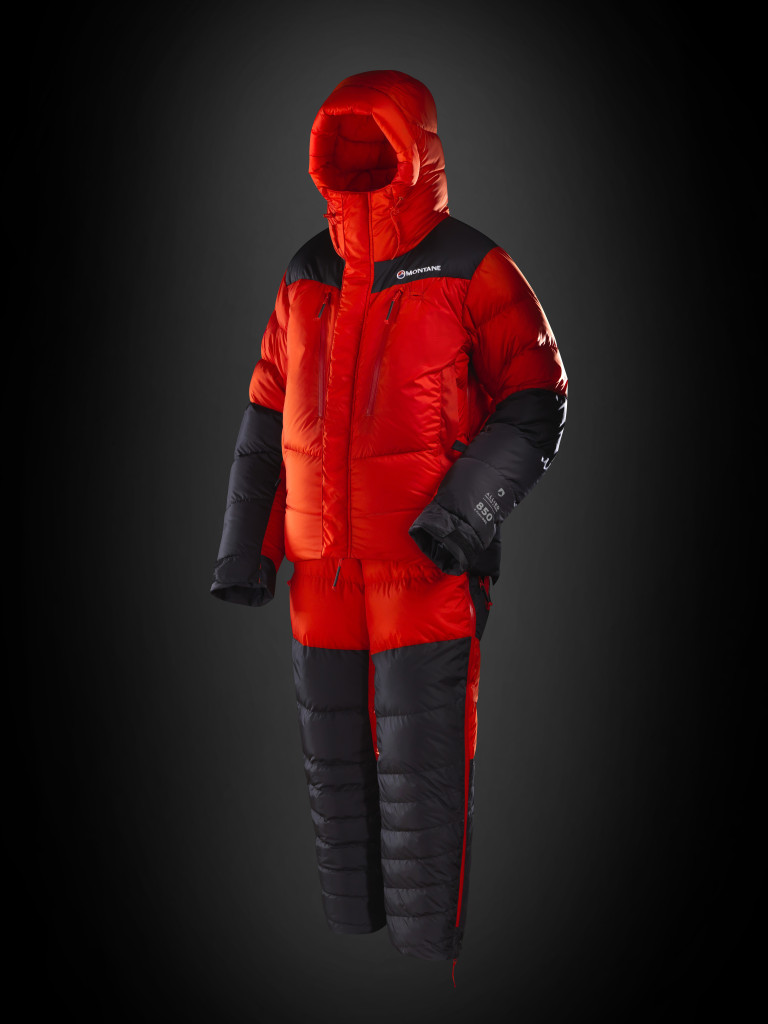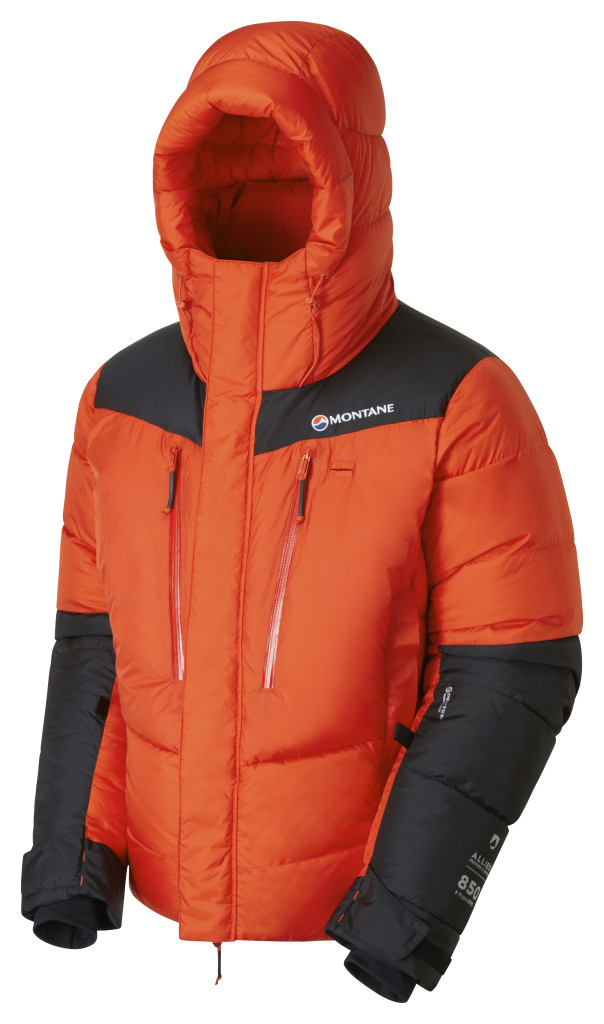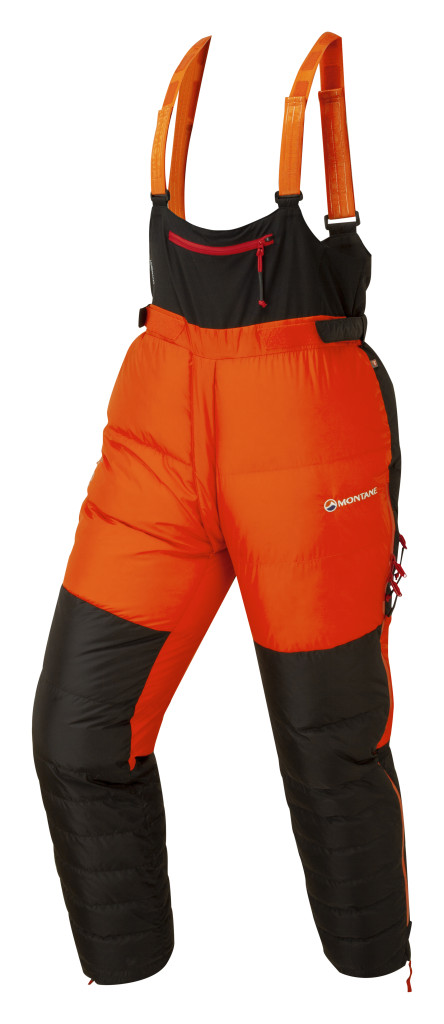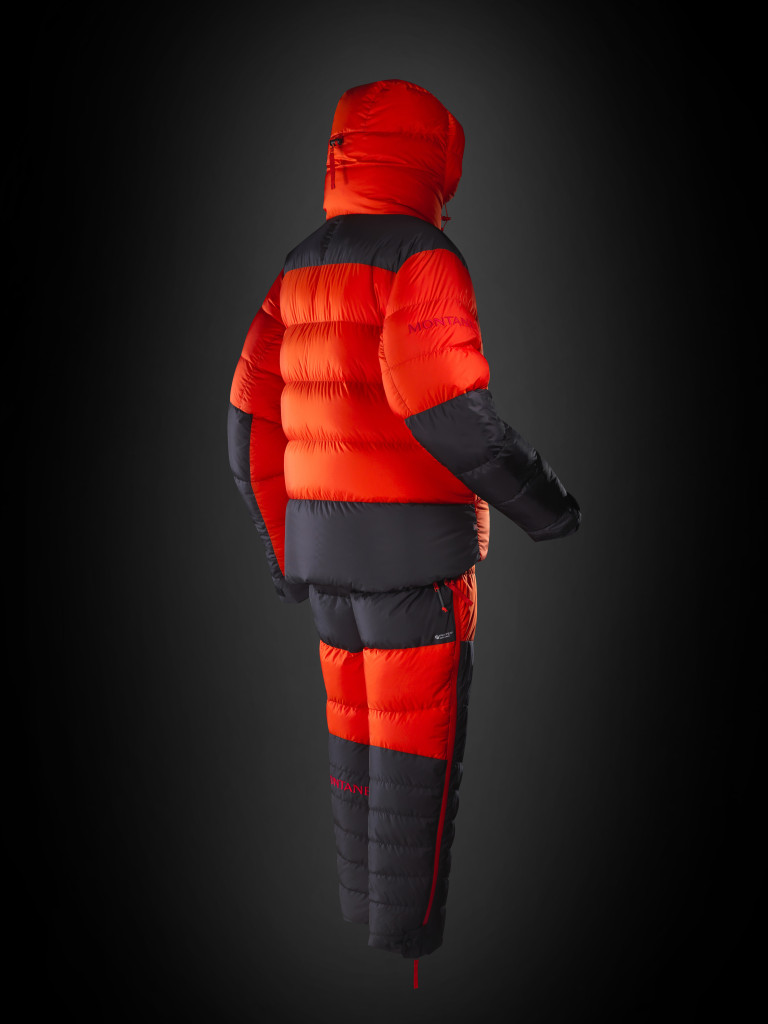The MONTANE APEX 8,000
A 2 PIECE DOWN SUIT
QUESTIONS & ANSWERS

Preamble …
How long have you been a mountaineer?
I climbed my first mountain, Helvellyn, when I was four years old! It was a family outing rather than a burning personal ambition so I didn’t do much outdoorsy stuff after that until I was in my teens. I started rock climbing properly when I was 22 and did my first lead climb, Little Chamonix, when I was 23 which was a life changing experience. That’s when I threw myself headlong in to all things outdoor related. I’d say that my mountaineering started from that winter onwards … so that’s 30 years ago!
What makes you go back to the mountains?
I love being in the great outdoors whether it be climbing, mountaineering, trekking, mountain biking, fell running or open water swimming. There’s something very special about our connection to nature and the freedom it brings along with the fabulous sunset, the brockenspectre, a rainbow, the temperature inversion, the starry night, a glimpse of a creature scuttling around in the undergrowth, the colour of the water in a river etc etc that can make for those special memorable moments. It’s a great place to clear the head as well. Added to that is the fact that I have been going to Nepal for over 20 years now and I have lots of friends, particularly in The Khumbu (The Everest region), who I have connected with over the years. Indeed a few of them have even visited my B&B in Keswick. That connection with the local people makes trekking and guiding in The Everest region extra special.
What is your first biggest achievement as a mountaineer?
I guess Helvellyn at 4 isn’t to be sniffed at. I went back again when I was about 9 with my Dad in wintery white out conditions. That was quite a challenging day because we were hopelessly ill equipped, I had freezing fingers and toes, it was windy and I now know with hindsight that I was walking along the cornice – in the great scheme of things we are lucky to have got away with it unscathed. I’ve had various epic days in Scottish winter which can be particularly challenging especially if you are willing to go out in all conditions. I guess that all these things together had prepared me for my first Everest summit on the North side in 2005. It was a particularly challenging season and the conditions were appalling but we managed to sneak up to the summit and back again in a 15 hour window after which the weather closed in again and a couple of people from another team unfortunately got in to difficulty and ended up dying.
How many times have you been up Mount Everest? What makes you keep going back?
I’ve been on 9 expeditions now and I have summited 6 times. It was only after my first summit with a bunch of mates on the North side that I realised that I’m pretty good at altitude. After that I really wanted to go back to the other side and try from Nepal. I did my first guided expedition in 2011 and then in 2013 I managed a double summit. I kept going back because I love my job.

~~~~~~~~~~~~~~~~~~
The APEX 8,000 from initial consultation to complete design
What do you look for in a down suit?
There’s more to it than just having a suit that is warm. Warmth should be a given. What you really need is a suit that will function in the most challenging conditions and it won’t let you down. When all is going well and the conditions are benign it’s not so important what you wear … but you have to be prepared for the worst that can be thrown at you and then it really matters. With clothing that is second rate you may well jeopardise your summit bid or even worse, your digits or even your life. Trying a down suit on in the shop and imagining what it is like to be in challenging weather is totally different to experiencing those conditions and managing to operate successfully in them. In that respect a down suit is quite a specialist piece of clothing and has got to be fit for purpose. Every aspect the suit needs to function correctly no matter how icy or frosted it becomes. Zippers that are too fragile, particularly when frozen, a hood that doesn’t stay up when the wind is in your face and pockets in the wrong positions are a few of the things that are obviously going to change the environment from comfortable to challenging. These, and other aspects, have been thought about and the solutions pondered and deliberated for many a meeting to develop a suit that is fit for purpose.
Traditionally down suits are one-piece.
What is the benefit of using a two-piece suit over a one-piece suit in your opinion?
I’ve used 2 piece suits for most of my Everest summits. I like the fact that when I am lower down the mountain I have a down jacket that I can wear when I am at, say Camp 2 on the South or ABC on the North. Indeed it also means that I have a down jacket (albeit a very warm one) for going to the pub in winter! The disadvantage is that the combination usually weighs a little bit more than a one piece suit but this is distinctly outweighed by the versatility. Added to that is that if I were to damage the top or the salopettes I’d only have to replace one item not a whole suit.

(*children are an optional extra and are not included in the 2 piece package).
~~~~~~~~~~~~~~~~~~
Can you tell us a bit about layering system and what you expect to wear on an 8000m+ peaks?
(of course, this is a guide and people have different ways of layering)
Personally I have a thin wicky and thick wicky set of thermals top and bottom … and then I have my down 2 piece. I also have a spare thin insulated layer just in case the conditions turn particularly nasty (and this also gives me a little bit of versatility when camping out at C3 or the South Col so that it’s not ‘all or nothing’ when I’m in the tent).
My extra layer of choice is the Montane Icarus Flight jacket that has insulation on the front, back, arms and hood but has a fleece panel along the side of the torso so it’s easy to work hard and stay warm without overheating.
The other aspect of layering that people often overlook is the need to keep the head comfortably warm but not too warm. So a beanie style hat and a buff are pretty much essential and they can be combined with the hood of the down jacket.
Once you are togged up and ready to go you’re probably not going to be taking your boots and socks off so it’s better to be slightly too warm than sightly too cold in the legs department … which is where leg venting on the suit can make the difference between being uncomfortably hot and sticky and being just right.
But if you get cold legs you will probably get cold feet no matter how good your boots are.
You have now worked with Montane in developing the two-piece down suit since December 2017.
How have you found the development from testing the first proto down suit, to now looking at the 4th proto?
It’s been a great journey because normally as a gear tester you get an item that is already in production and write an article and give it a mark out of ten. Developing the down 2 piece, though, has been a great experience because my input has been turned in to the various manifestations of the 2nd, 3rd and 4th generation of prototype. It’s great to get an in depth knowledge in to the pros and cons of various zippers, for instance, or materials and understand what might work in one area of the garment won’t necessarily be suitable for another.
Can you explain the process and ideas throughout the development? And places that was lacking and needed more attention?
We started out from the viewpoint that everything had to be fit for purpose. However this is often skewed by the benign conditions of an office and it’s only when you use an item in a real life situation for multiple days that you realise what isn’t working, what needs improving and what you have got right.
The difficulty with a down suit, however, is that you need to be in an extreme Polar or Himalayan environment to give it a rigorous test. It’s not like testing waterproofs, for instance, which can be done in a matter of weeks (or even days) pretty much any time of year. So that timescale has been quite long for testing.
The other issues we faced was that the thoughts and designs we sent to the factory weren’t always interpreted in quite the right manner and what came back wasn’t always what we had envisioned. This is a difficult area because there may be one word that is being misinterpreted and it completely changes the nature of the sentence in the design brief and hence the outcome.
Now you have seen the 4th proto, can you run through the features from top to bottom and the importance of these features?
Well starting at the top there’s a great hood with a baffle round the collar. A hood would seem to be a simple affair but they’re actually incredibly complicated because it needs to blend with the top of the jacket as well as sit well on the head and be easy to adjust when wearing big mitts. Indeed all the adjustable areas on the entire suit have to be able to be operated with big mitts or thick gloves. I’ve seen hoods that have blown off when facing in to the wind, I’ve seen hoods that seem to be fine until you add the oxygen mask to the set up and I’ve seen hoods that just didn’t fit over a helmet! What we have designed here is a hood that does all those things and is very simple to adjust.
Next we have some heavier weight panels in areas of high wear which is fairly standard these days and we have gone for a robust zipper for the front of the jacket. There was a trend when zippers were getting thinner and finer but when you see the Climbing Sherpas using them they are really really careful, especially when everything is frosted up, and don’t just do them up with a whoosh because they understand the importance of not blowing a zipper otherwise the integrity is immediately compromised. That’s when we went back to a more robust and heavier weight zipper to cope with being frozen and being easy to use with mitts / thick gloves.
In the shoulder and the back we have chosen to use Primaloft as well as down. This is the kind of thing that could easily go unnoticed when trying it on but the benefits are enormous. Down loses quite a lot of its thermal properties when it is compressed, hence using Primaloft as an additional layer in the shoulders. The other drawback of down is that it can move around quite a lot, which can create cold spots in the compartments, and it tends to get clammy when sweated on … hence using Primaloft for the inner insulation in the back of the jacket which supplements the down which is in the outer compartment. That also means that the additional moisture when you’re wearing a rucksack gets wicked away whilst keeping you comfortable and warm.
There are a couple of chest pockets which are ergonomically placed to be in exactly the right position and at the right angle and with the right depth. The depth of any pocket is limited by seems within the garment and if you make panels too long or wide then the insulation can end up floating around and creates cold spots. So we feel that we have balanced the size of the pockets with all those considerations. On the right pocket there is then an inner zip that gives access through to the inside of the jacket which, again, had to be placed in just the right position to make it work. Initially we had a situation where it was easy to open but a bit of a struggle to close again so we worked on this until we got it right.

Inside the jacket are a couple of mesh pockets for 1/2 litre Nalgene bottles and an additional inner pocket for the modern adventurer … a place to put their smartphone and their GoPro. We decided that these items needed to be deep within the jacket to keep them warm but still be accessible for this must have selfie moments. For added security there’s also a small keyring clip in case folk want to attach their beloved device on a length of cord so they can’t lose it if they drop it (it’s easy done with big gloves on).
There are a couple of hand warmer pockets lower down the jacket for when you’re stood around enjoying a bit of down time at camp. These mean that the jacket isn’t only meant for Himalayan mountaineers but make it ideal for anyone operating in an extreme environment particularly if they may have some time when they are stood around – for instance camera crews, photographers and star gazers etc.
Another area that is possibly a bit more complicated than people realise are the pit zips. If they aren’t positioned just right they either won’t undo or they won’t do up or they get compromised when you add a rucksack and / or a harness. Again we worked through the various options and the pros and cons of different positions, different lengths of zipper, different weights of zipper, whether it should zip up to open or zip down to open or a bit of both. And the position has to be just right to allow for effective dumping of heat without compromising the fit. We have opted for a midriff to elbow opening as we felt that this was the best solution given the various obstacles that can hinder its operation.
There are some great hobo mitts incorporated in to the ends of the sleeves and on the left one there’s an opening so that your watch is accessible. This is a seemingly tiny point but if you are wearing a liner glove, then have a hobo mitt over the top and then a down mitt and then the sleeve it is a bit of a job to get down to your watch and see what time it is or what elevation you are at. Indeed with some of the suit configurations out there you would have to remove your mitt altogether to get access to your watch which potentially compromises everything if you end up losing the mitt in the process. With our new system you just need to move the sleeve up a tad, move the down mitt down a tad and there’s your watch. Such a simple idea but it’s only a matter of time before it appears on other makes and models of down suit.

With the salopettes we worked hard to get the right amount of coverage at the front to allow for a decent sized pocket but without bringing everything up too high which affected the effectiveness of the braces. The braces are in a funky orange elasticated material which is soft and comfortable so that it won’t be a rub point below the rucksack strap. The pocket was designed to be integrated with the access from the right jacket pocket so that when you reach through the zipper is in just the right place and is easy to work through all that material.
We went for a jacket with quite a reasonable length so that if it is being worn without the salopettes it still covers the kidneys and bum. But that meant that the salopettes started out being way too warm around the hips where they overlapped with the jacket and so that has been scaled back get the right combination of overlap and warmth.
Next up we chose to have a fly zipper that undoes from below which allows for instant access for the gents. With a fly zipper that goes down from the top if it is situated too high or the opening is too small it can become a bit of a fiddly issue. This is obviously only relevant to 50% of the population and so we also discussed what style of access for ladies and for number 2s. We felt that the disadvantage of an up and under arrangement was that it can still close up when in use unless the two sides are held apart … which makes for a two handed balancing act. The other area of potential conflict is when you’re wearing a harness in that the back zipper may not be accessible or it may end up under the harness or rucksack and be pushed in to the lower back making for a painful experience. We therefore opted for a rainbow access flap which has a zip pull at both sides so no matter whether you are left or right handed you can reach around and undo it easily even whilst wearing a harness. You can then pull the drop seat forwards and tuck it in to harness leg loop to free up the hands.
The design team hadn’t initially realised how important it is to be able to dump heat from the thighs and after much discussion we settled on a triple zipper for a variety of reasons. Firstly it allows for easy access when putting the salopettes on as the leg can be opened up from the ankle all the way up to the hip. Secondly, when the salopettes are on the middle zipper can be lowered to create an opening. But you don’t necessarily want an opening that just gets bigger and larger as you undo the zip and so a third, top, zipper can be used in conjunction with the middle one to move that opening up and down the leg as required. Added to this are some strategically placed poppers to stop even the largest opening from just flapping around.
Again there are strengthened panels where required.

~~~~~~~~~~~~~~~~~~
Is it safe to say that you are confident in using a Montane two-piece down suit?
Absolutely. It won’t get you up and down the mountain, you have to do that. But what it will do is keep you warm and safe whilst you’re on that journey and you won’t be compromised in the process. Indeed if the conditions turn out to be particularly challenging this could well be a life saving piece of equipment.
What would your advise be if someone is looking to attempt any 8000+ Mtn (like Everest)?
It is very easy to go ill prepared and there is absolutely no substitute for being technically competent and extremely fit. The more relevant experience you have the better which means getting fit outdoors rather than in the gym and knowing how to use all your gear, whether it be clothing or technical equipment, intimately. As far as gear and clothing goes do not settle for second best because your life may well depend on it.
~~~~~~~~~~~~~~~~~~
The Montane APEX 8000 will be on the market from September 2020 onwards. The jacket will cost in the region of £500 and the salopettes around £360. This makes it a very competitively priced option and, as a result, puts it at the No1 spot for my choice of down suits.

